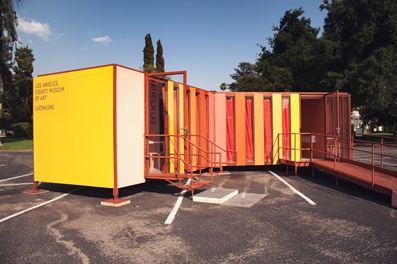Last week LACMA launched an ambitious new program, the LACMA9 Art + Film Lab. The mobile lab, designed by Jorge Pardo, will spend the next sixteen months visiting nine communities in Los Angeles and San Bernardino Counties, starting in Redlands and continuing to San Bernardino, Monterey Park, Altadena, Compton, Torrance, and more. For five weeks in each community, the lab will offer free filmmaking workshops, free outdoor movie screenings, and the chance to collaborate with artist Nicole Miller on an artwork that will be on view at LACMA on select Community Days. Unframed’s Scott Tennent asked Hanul Bahm, Community Engagement Manager, for details.
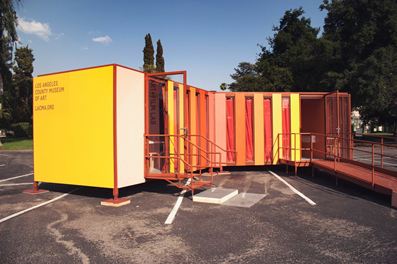 LACMA9 Art+Film Lab, photo by Duncan Cheng
LACMA9 Art+Film Lab, photo by Duncan Cheng
How did the Art + Film Lab come about?
The James Irvine Foundation has been working really hard in Southern California to reach certain communities that are geographically underserved or where there’s not a lot of arts and cultural infrastructure. They’ve taken it upon themselves to give seed money to small grassroots organizations, as well as large institutions like LACMA, with the hopes of bringing arts programs to diverse, regional communities. We proposed the LACMA9 project because we felt it would be an extension of the in-depth outreach we’ve been offering for over a decade within libraries, community organizations, and schools.
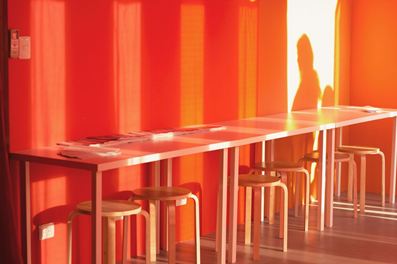 LACMA9 Art+Film Lab, photo by Duncan Cheng
LACMA9 Art+Film Lab, photo by Duncan Cheng
How did Jorge Pardo become involved in this project?
When we decided that we wanted to offer this mobile art and film programming, we realized that it would be great to provide it in a vessel that felt like an artwork. Jorge Pardo’s practice lives at this intersection of sculpture and design. He seemed like a natural to build a lab space that would stand as a public artwork, but that would also have the functionality to offer programming. It’s a very happy, inviting space, which is good. Sometimes out in the community there’s a perception that art museums are either inaccessible, elitist, precious, or out of touch. I think the lab will draw people just out of the sheer joy it radiates. We want to get to know the residents of these communities by being their neighbors for five weeks and building those bridges. The Art + Film Lab is like a “mini-me” of LACMA. Through the inviting space created by Jorge’s sculpture, added to all the really rich, creative, free programming we’re offering, we wanted to introduce ourselves and provide a small taste of what’s available at LACMA.
Tell me about the programs offered in the lab. Who can participate in the workshops and what do they need to bring?
You just have to bring yourself. We know the people coming into the lab will have various degrees of arts background or access to tools—including none. We welcome complete beginners. We’re trying to focus on what’s empowering about the filmmaking and video art process, which is often collaboration—the collective genius of a group working together. The workshops are about process and play.
There was a hope from LACMA and also from the Irvine Foundation that we try to reach adult audiences as a priority. We won’t discourage kids and teens from coming. But we really want to reach adults and give them the opportunity to try new things or explore their personal voice. This is like our red velvet cake for them to come and enjoy and meet other adults in their community, and play filmmaker or video artist for a day.
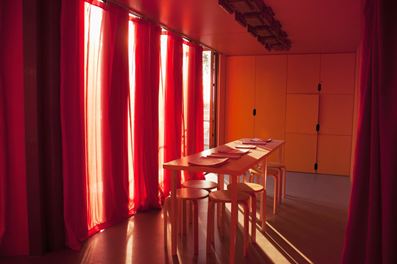 LACMA9 Art+Film Lab, photo by Duncan Cheng
LACMA9 Art+Film Lab, photo by Duncan Cheng
What are the free art and filmmaking workshops?
There are four kinds of introductory workshops. “Soundscapes” explore all the elements of a soundtrack, in addition to what composers contribute. Environmental sound, like the hum of an air conditioner or a dripping faucet, can create emotional, psychological, subliminal tension in storytelling. We’re giving people sound recorders to record environmental sounds. We’re also showing them how they can create sound effects, or foley, from everyday objects. “Composition” is very much about shot design, quality of light, and the frame size of your shot. This is a moving image medium; unlike a painting or a photograph, you can focus the viewer’s gaze on what you want to bring their attention to, over time.
Another workshop, called “MiniDocs,” helps people find their personal sense, or subjective relationship, to people and place. We’ll probably go on mini field trips together with cameras to different locations to make a brief document that explores the essence of a person or place’s character. The last workshop we’re offering is called “Instant Film,” which simulates the production pressure and creative constraints that artists and filmmakers work under. We’re grouping people into small crews of three or four. They draw a theme out of a hat, and they have to interpret that theme and also brainstorm creative constraints—like maybe their video has to be one shot without an edit. It’s highlighting how creativity often happens within parameters, and you have to be resourceful when faced with a problem. We’ll set them out to create something on the spot as a group, then we’ll bring it back to the lab for an instant screening.
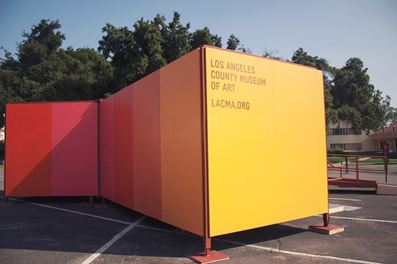 LACMA 9 Art+Film Lab, photo by Duncan Cheng
LACMA 9 Art+Film Lab, photo by Duncan Cheng
In addition to the free workshops, you also have free outdoor movie screenings on Fridays and Saturdays, right?
Southern California has a really rich legacy of drive-in cinemas, which in different cities has evolved into movies in parks. We are bringing really wonderful films—what we humbly hope other audiences will consider great films—including Hollywood classics, foreign films, and independents from all around the world. This weekend in Redlands, for instance, we are screening Stand and Deliver and The Last Picture Show.
[youtube=http://youtu.be/3YQomR5xJ_Y]
One of the most unique and exciting parts of the Art + Film Lab’s program is an oral history project, in collaboration with artist Nicole Miller. How can people participate in this project?
Nicole Miller has a unique practice that is a hybrid of documentary and video installation art. She explores notions of self-representation, in contrast to representations in popular media. The oral history project lets people play either interviewer or storyteller in front of the camera and draw on a personal memory or a significant moment in their lives. They get to make a document of that in front of the camera, and they’ll get an instant, unedited copy on the spot. Nicole will review the documents created by the community members, and then she’ll contact a few people in each community to make a collaborative work that will screen at LACMA on select Community Days. That’s the final component of our programming: once we’ve finished our five-week residencies in each city, we’re inviting everyone back to the museum to enjoy LACMA for free on select Sundays. We’ll have arts programming there for families and communities to enjoy, and we’ll screen Nicole’s work. It will come full circle—we’re going into their communities, and we’re hoping that they’ll come back and visit us.
The Art + Film Lab will be in Redlands through July 7. Free outdoor screenings are offered every Friday and Saturday. For dates and times of free workshops and Oral History Project, as well as a full listing of future Art+Film Lab destinations, visit the Art+Film Lab page.



